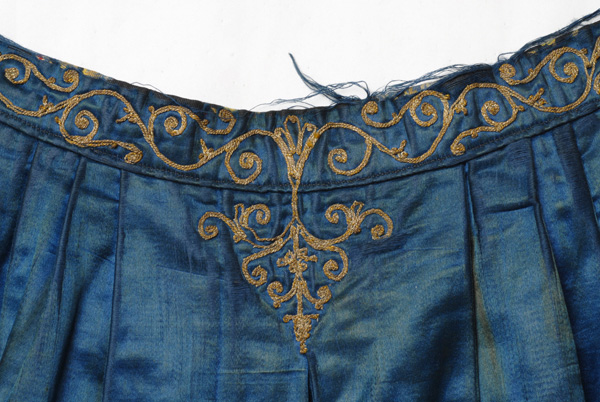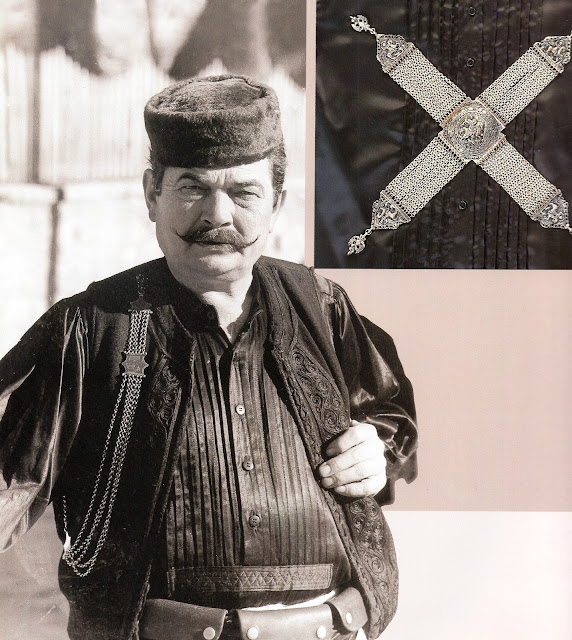Hello all,
Today I will continue my series on Epirus costume by talking about Metsovo, Μέτσοβο; in Vlach, Aminciu. This municipality lies in the Ioannina regional unit, on the eastern edge, and borders Thessaly.
Metsovo is a very old settlement, owing its existence to the Roman road Egnatia, built in 146 BC. Because of this, the local people speak Vlach, a Latin-derived language among themselves, although they also speak Greek. Metsovo held a high status and various priviliges during the Ottoman Empire. Metsovo is the largest center of Vlach culture in modern Greece.
This region relied heavily on the raising of sheep, and because of that, developed a great tradition of weaving and textiles as well. They were traditionally well off because of the wool trade.
https://en.wikipedia.org/wiki/Metsovo
The traditional outfit of Metsovo women comes in two forms, the regular daily outfit and the dress outfit. The dress outfit is made and embroidered by professional tailors, but the pieces of the daily outfit are made at home. Here is a photo of a group of people in the daily costume.
I assume that there is a foundation layer of linen or cotton, pokamiso, although it is not visible when women are dressed.
The basic garment is called fousta. This is home woven of wool, often in plaids. It has a sleeveless bodice, and a lower part that is gathered into the top. It may have ornament added to the hem. Here is the only image of this garment that I have been able to find. See also the photo above.
Over this is worn the kleisto, a sort of jacket or blouse that comes to the waist.
For dress occasions, it is made of simple calico, with the front and lower sleeves of a rich material, because those are the only parts that show. For everyday, the bodice is usually made of the same material all over, except perhaps for the lower sleeves, and often has shorter sleeves. Both versions tend to have a row of cord applique down the front opening. This is done by professional tailors.
A couple more images of the daily outfit. Widows, as in many other places, tend to wear black instead.
 |
In colder weather women wear various wraps and shawls. One in particular is notable, the Khramia kefalis. This is a rectangular cover, woven in the same fine kilim weave that is used for cushions, seatcovers, tapestries, etc. Because these are hand woven, the width is limited, and so larger pieces are made of several fields sewn together.
For dress occasions, the kleisto or manikaria has lower sleeves and front made of fine cloth. The rest of it is often made of cheaper cotton, because it does not show when fully dressed. Here are some examples. The sleeve ends often have a glossa, or tongue, which may be vestigial cuffs. This is still put on over the fousta [and maybe pokamiso].
Over this is worn the foustani, a long garment made of fine cloth, with an opening in front that shows the front of the kleisto, and long slit sleeves. The sleeve ends of the kleisto are visible, and the foustani sleeves are often pinned up to show them off. The foustani was traditonally made of fine silk brocade.
A newer style has the foustani made of cloth which is not quite so sumptuous, but has black velvet cutwork applique applied to the hems. This is reminiscent of some of the Folk Costumes of central Spain. The velvet is cut by professional tailors, but sewn on to the foustani by the women themselves.
Over this is worn a knee length heavy black wool vest called flokata. This is similar to those worn in Zagori and Konitsa, but those worn in Metsovo had the ornament limited to a band of red applique applied to the edges and the pockets, similar to that worn in Eastern Konitsa. This is a distinction granted by the local Sultan in the days of the Ottoman Empire. Aristocratic women wear two bands on their flokata.

The dress apron may be similar to the daily apron, only made of finer materials, as we see here and above. These are often of satin with floral embroidery.
Alternatively, a dress apron may be purchased from the professional tailors. These are also of fine cloth, in various colors, have a rounded bottom edge to which is sewn a pleated flounce, and are embellished with cord applique or floral embroidery.
A dress belt and buckle made of metal are worn with these.
Today a dark kerchief with ornamented edges, tsipa, is tied on the head. Here are a few examples.
For the greatest occasions, such as weddings, more elaborate jewelry may be worn, including braid decorations, caps - tarboush, even more elaborate belts, etc. Also a special pokamiso is worn, with the collar and cuffs visible. The hair is braided and wrapped around the head, and the older, more elaborate headdress is used. A ring of fake hair is added as needed.
Men
Men wore two basic types of costume in this region. The first is called Bourazana. This is shown above on the left. The second is called Dimita, this is on the right.
The Bourazana is named after the trousers, which are made of wool and taper somewhat towards the ankles. They are traditionally black or indigo, although more recently festive ones are made in white. They are worn with a full sleeved shirt that has many pleats on the front, a wool vest with cord applique, a sash, a round cap and tsarouchia. A leather belt with pockets may be worn over the sash, and in older times would have held weapons.
The Dimita costume is more complex and is much more common today.
The shirt, kameasha, is the same, traditionally made of wool, but black satin is used for dress today. Tight fitting white wool hose are worn on the legs. These are accompanied by black garters with tassels, and tsarouchia.
Over the shirt a double breasted vest is worn, in most parts of the Balkans called dzhamadan, but here called tsamandamou. It is ornamented with cord applique. This is usually black or very dark indigo. In modern times, this garment is sometimes omitted.
Over this is worn the dimita. The front is open to show the tsamandamou, but it is closed at the waist. The lower part is very full, and is pleated into the upper part. This garment reaches to mid thigh, and is black, dark blue, or occasionally, white.
Two types of mantle like overgarments are used, The first is cut somewhat like the dimita, with a full skirt. This is woven of wool with a sort of artificial fleece woven in, rather like the hunia of Transcarpthia. Here is a man wearing this with the bourazana.
I will close with some more images of this outfit. It is a popular subject for photographers.

.png)

































































































































































































I love foklore costumes and clothing. So inspiring!
ReplyDeletethese look like Middle Ages design, thanks Roman for sharing, much appreicated
ReplyDeleteHi - I am the editor of a needlework magazine—PieceWork, and I would be interested in speaking with you about a future article. My email is POlski@LongThreadMedia.com. I look forward to hearing from you. Pat
ReplyDeleteThis is a great blog post, thanks for sharing. Really excited to read more desire more!
ReplyDeleteThis comment has been removed by a blog administrator.
ReplyDelete